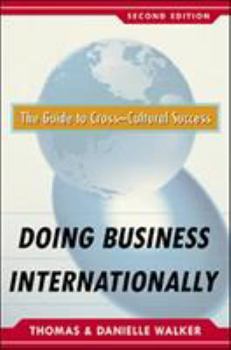Doing Business Internationally, Second Edition: The Guide to Cross-Cultural Success
"This is an important and excellent book for every negotiator." -The Negotiator Magazine The premier guidebook for conducting cross-cultural business Doing Business Internationally, Second Edition, is a nontechnical, accessible resource for managing today's multicultural organizations. Revised, restructured, and refocused from its classic first edition, it introduces the revolutionary Cultural Orientations Inventory...
Format:Hardcover
Language:English
ISBN:0071378324
ISBN13:9780071378321
Release Date:August 2002
Publisher:McGraw-Hill Companies
Length:288 Pages
Weight:1.60 lbs.
Dimensions:1.3" x 6.3" x 9.3"
Customer Reviews
4 ratings
Practical guide to understanding other culture
Published by Thriftbooks.com User , 15 years ago
The book starts slowly and it has some useless information. It basically tries to convince the reader that understanding other cultures is important. Well, if I didn't think so, I wouldn't have bought the book in the first place. Then, there is some generalities about business, wrapped up in a lot of business/MBA BS. But it gets better. Then, they lay out a method of classifying cultures with several measures that do make sense. Then, there is a quick survey of several cultures. This section is extremely useful. I grew up in France but I have now lived in the US for 6 years. Their analysis is true, but it also puts a structure on the observations I made. Working with Chinese, Japanese, and Korean folks, I agree with their presentation. Form inside or outside a culture, it helps understanding how you react, and how other people react. The book doesn't make value judgments on cultures peculiarities, just gives the information. I would say it's a must read, especially when it is below 20 bucks. Just skip the beginning.
Excellent book for learning more about managing multicultural organisations.
Published by Thriftbooks.com User , 18 years ago
This is an excellent book for learning more about managing multicultural organisations. Already in its second edition after being first published in 1995, it has improved. The COM or Cultural Orientation Model integrates all the cultural dimensions of famous authors Hofstede, Hampden-Turner and Trompenaars, Stewart and Bennett/Rhinesmith, Kluckhohn and Strondtbeck/Hall and Edwart Hall into a cartwheel. Though the authors are very much pro-convergence (even claiming in Chapter 1 that Global harmonization of consumer buying preferences will dominate certain industry-goods and services-sectors.) as to Globalization they manage to build up a comprehensive argument about the high role of culture in the process of organizational globalization. Busy international managers could find the approach of breaking the complexities of cultural differences into value orientations a bit theoretical in the absence of case examples and critical incidents. There are some good case studies in chapter 4:A Survey of Cultural Patterns but there are too few of them in the whole book. In fact more of these would have helped in getting a vital point accross that cultural boundaries are not national boundaries. For people involved in designing performance management systems and strategic planning in multicultural organisations this book is highly recommended reading. HR-practitioners in multicultural organizations would also benefit from reading this book.
Which type is to become a global manager?
Published by Thriftbooks.com User , 23 years ago
Recently I wrote a book about multinational management published in 1968. After finishing this book, I realized that the conflicts between multicultural and multinational difference are stands still under the similar managerial circumstance, though we are living in the digital-dominated world. So I studied this book compared with its' phenomenon as described in "International Management". Keeping a flexible communication skill in multinational-cultural is the key factor to achieve meaningful outcome. For this, the open-minded, instructive and far-sighted personality required first. When they acknowledged difference not wrong each other, they can start to talk about what they want for negotiation, next proceed to persuade or yield a little. This means the more internationalized people there as a matchmaker, the more the company benefited from them. Then how to get Mr. Right for global manager? They all born naturally? Or trained? Both are all right. Person who has got global brain with digital management skill (as Mr. Bill Gatz called) must appeal to adapt extreme change and more action to cope with international risky problem. They could continue to get or lose by trial and error and learned what's the best, step by step and case by case. There are no standard learning system to teach them. That's not the lost rather than investment for human resources for each company ultimately. If you are would-be-global manager or second-rate reginal manager or have a dream of international manager, read this book and write down and analyze what's your strong/weak point more carefully. Then take into action to the first-rate global manager. If anyone who is in a top-management read, they can set effective multinational goal to come and get. How about students or average person? Of course, they will be fine.
Valuable guide to building a successful worldwide company.
Published by Thriftbooks.com User , 26 years ago
This book should be on the desk of every marketing and human resources manager involved in foreign trade. It is not only for larger companies that have already built a global sales network. It is also for beginners who should consider these cross-cultural factors BEFORE they start selling their goods and services in overseas markets. John R. Jagoe, Director, Export Institute.





